|
BACKGROUND
PAPER (Second Revision, May 1, 1991)Prepared
by: LTC (Ret) Ralph R. Hoppe
Subject: Personal Synopsis of the USS Liberty Incident.
1. On the day of the Israeli attack upon the USS Liberty, June 8, 1967, I was Chief of the Middle East Intelligence
section within the J2 Directorate, USCINCSTRIKE/USCINCMEAFSA, located at MacDill AFB, Tampa, Florida. My duties at the
time were focused upon the analyses of military/political/economic activities of the belligerents of the 1967 Arab-Israeli
Six Day War which had commenced on June 5, 1967.
2. For those unfamiliar,
the intelligence mission is essentially threefold: collection of information; analysis of collected information and
distribution of analyses (of which I was a part); and special operations (including, but not limited to "dirty tricks").
Most intelligence activities are conducted in a restrictive, cellular atmosphere and their output is distributed to the users
(operational troops and decision makers) on a need-to-know basis. Security classifications are absolutely necessary
within the entire intelligence process to properly protect the identity of sources, whether they be PHOTINT, SIGINT or HUMINT.
3. Intelligence dissemination is therefore complicated. Vital, available
information can easily fall through the cracks, as it did during the USS Liberty tragedy, unless the whole team at all levels
is determined to disseminate all facts in an unbiased manner. Some problem areas are discussed below:
a. Dissemination bears many different types of security classifications to properly safeguard a myriad of sources.
As most people are aware, the common classifications are CONFIDENTIAL, SECRET and TOP SECRET, each having their own special
handling instructions. Higher classifications and/or more restrictive caveats are added to the documents commensurate
with increased sensitivity of the sources.
b. Many documents contain
more than one source. In such cases, the entire document carries the classification of the most sensitive sources.
c. A series of documents covering the same subject may individually carry separate
classifications from CONFIDENTIAL to the highest levels.
d. Most intelligence
information arrives as incomplete spot reports from varied sources on a piece-meal basis. Many spot reports are often
needed to complete the picture.
e. Each document is delivered only to need-to-know
persons having access to that classification. It follows that as the sources become more and more sensitive, more and
more people will be denied access to the information and will never know the existence of additional documents which make
up the complete picture.
f. Conversely, those that possess the highest clearances
(the President, SECSTATE, SECDEF, Dir CIA, Dir NSA, Dir DIA, etc., and their top horse-holders) are most often too busy with
other tasks to do much more than read intelligence summaries of items considered significant by their analysts. This
system appears workable on first glance, but is ofttime compounded by strong differences within analytical processing as to
which items can/should be considered significant. (Let's face it! Each batch of new intelligence information brings
new twists to old methodologies.)
4. Israel won a major victory over the Arabs
in the 1967 War. Hostilities had been preceded by Arab threats, Egyptian closure of the Straits of Tiran, mobilization
by both sides, and pull-out of UN peacekeeping forces. On June 5, 1967, Israel initiated hostilities (verified by US
intelligence) by invading the Sinai with ground forces and attacking airfields in the Sinai and elsewhere within Egypt.
By the time a ceasefire had been agreed upon at the end of 6 days, israel had seized and occupied the entire Sinai peninsula
up to the Suez Canal, the Gaza Strip, the West Bank and Jerusalem, and Syria's Golan Heights. (The reader is reminded
that these seized territories, with the exception of the Sinai, had been claimed publicly in 1948 by leading Zionist leaders
– including later-to-become prime ministers Menachem Begin and Yitzhak Shamir – as rightful parts of reconstructed
eretz Israel, the Zionist historical homeland.) One of the more interesting Israeli versions of the Liberty incident
(inferring that secretive U.S./Israeli agreement had been seriously bungled by both sides) was written by Chaim Herzog (The
Arab-Israeli Wars, Random House, N.Y., 1982).
5. Prior to the commencement
of hostilities, President Johnson and SECSTATE Rusk openly pleaded with Israel to refrain from executing a preemptive strike;
following the Israeli attack, the U.S. continued to openly press for an early cease-fire and separation of opposing forces.
Israel, winning handily from the start, paid lip-service to wanting an early end to hostilities, but it's clandestine, accelerated
military movements left no doubt to U.S. intelligence that the Israelis weren't about ready to stop until they had achieved
their planned objectives (which clearly coincided with the territories which they seized before accepting the cease-fire).
Upset with the Israeli deceit (or bungling previous secretive agreement), the U.S. increased its intelligence collection of
Israeli activities. The Israelis immediately objected to the U.S. action.
6.
The USS Liberty was moved into the eastern Mediterranean to monitor both Arab and Israeli military activity. For an
outstanding account of the Liberty's activity before, during and after the Israeli attack by one of the ship's officers, read
James Ennes, Jr., Assault on the Liberty, Random House, N.Y., 1979.
7. As
the Liberty approached Israeli shores, Israeli Defense and Foreign ministries began pressuring the U.S. Embassy in Tel Aviv
to ascertain whether it was an American ship and, if so, to determine why was there and what was its mission. According
to Israeli reports covered in the press, the U.S. Embassy initially pleaded ignorance to the ship's arrival, but promised
that they were making every effort to get an answer. (Most U.S. State Dept reports of that series of dialogues which
I saw at the time were never divulged to the press, but certainly are available in permanent files and could settle the argument
if the U.S. ever agreed to release them.) The longer the U.S. delayed, the harder the Israelis pressed for an answer.
About 24 hours before the attack against the Liberty, the exasperated Israelis reportedly informed the U.S. Embassy that lacking
any positive answers from the U.S. they could only assume that it was a belligerent ship which is fair game under the rules
of warfare.
8. To further build their case, the Israelis claimed at the time
that if it were not a U.S. ship, it was most probably an Egyptian ship (named al Kusayr/Kusair). This claim was plain
BS because the ship that they named was clearly identified in Janes Fighting Ships, a copy of which, I am sure, could be found
in every Israeli ship and military headquarters. (If Israeli pilots could differentiate between Egyptian and Israeli
tanks, artillery and trucks in battle areas, they should certainly have been able to identify anything as large as the Egyptian
ship in open water.) Moreover, the configuration of the named Egyptian ship was considerably different from that of
the USS Liberty.
9. Two first-rate analysts from our (STRIKE) intelligence
section sensed quickly from in-coming reports that the attack upon the Liberty was deliberate. (One of the analysts
was an AF major, whose name I have forgotten, but which could be obtained from official records. The other was an Army
captain, William Kirby, who shortly thereafter transferred administratively from the Army to the Dept of State. The
last time I saw Kirby was September, 1974, in Tel Aviv, where he was assigned to the U.S. Embassy.) We immediately contacted
the U.S. analytical intelligence community in Washington D.C. (State, CIA, NSA and DIA) individually by secure telephone to
get a consensus on our conclusion and were pleased to find that the community's analytical personnel (our counterparts) unanimously
agreed that the Israeli attack was deliberate, not accidental. Their analyses, too, had been performed independently
and included all available "raw data", from unclassified sources through special intelligence; to be more specific,
many dozens of documents, from a large array of sources, were studied, verified and correlated before reaching a conclusion.
Unfortunately, the final clincher came from about a half-dozen sensitive documents which for security reasons will most probably
never be released to the public in their entirety.
10. My and my counterparts' superiors
immediately brushed aside each independent analytic conclusion, which previously had been collectively agreed upon orally
by secure telephone. Moreover, our superiors placed a word-of-mouth lid upon the normal written dissemination and sensitive
backup documents were withdrawn from circulation. STRIKE J2, AF BG Gibbons, assured me that the conclusion of the intelligence
community would be released in good time following appropriate diplomatic negotiations. I have no doubt that Gibbons'
statement was made in good faith to me at the time, but was over-ruled by higher circles where "you-scratch-my-back-friendships",
not integrity, are prime considerations.
11. Shortly after the end of the Six Day
War, BG Gibbons directed me to assemble all the documents we (STRIKE) used as backup to support our Liberty incident conclusion
and take them to the Pentagon to compare notes with DIA analysts and the U.S. Military Attache to Tel Aviv, Colonel Perna,
who was returning to CONUS on leave. It was upsetting for me to learn upon arrival that the sole purpose of the meeting
was to provide an assembled package of back-up documents for Colonel Perna to read. It was equally upsetting to learn
that my package from STRIKE was considered much more complete than that supposedly prepared by DIA during the crisis and therefore
selected as Perna's reading file; I, in turn, obviously was designated as defender of the conclusion. When Perna finished
reading, we (the analysts from DIA and I) asked his (as well as the US Embassy's) opinions on our conclusion. He cut
us short except to say that Israel needs our help. To me, his retort was disgusting and immediately prompted me to wonder
whether he would let our sensitive information "out-of-the-bag" to the Israelis. (Though I have no facts to
prove that he did, I was soon to learn that his feelings – "needs our help" – were shared by much of
U.S. officialdom.)
12. I was pleased to hear that several governmental agencies
decided to undertake hearings, but I wrote them off as a "whitewash" as soon as I learned that none of the senior
intelligence analysts within the Washington, D.C., area had been called to appear for questioning; yet, their top bosses,
the ones who had brushed aside the analytical opinions, were called because they possessed knowledge of "all the details".
Concurrently, all the information provided by the Israelis appears to have been accepted as fact without cross-examination
under oath. The final opinions expressed by the hurriedly assembled boards of inquiry (meeting behind closed doors)
that they could find no evidence to suggest that the Israeli attack was anything but accidental, should be taken with a grain
of salt until the boards show that they have the guts to explain in detail the rules under which the hearings were conducted.
As a minimum, the explanation should include: specific purpose; evidence to be admissible; specific rules for questioning
(w/wo restrictions); rights to cross-examine evidence provided orally or written (w/wo restrictions); the selection process
for persons to appear before the hearing.
This personal synopsis is unclassified.
I am prepared to defend foregoing information (12 paragraphs; 8 pages) by cross-examination under oath, or even polygraph,
provided that all those that made the decision to stop dissemination (see para 10) undergo the same.
(Signed)
RALPH R. HOPPE
LTC (retired)
U. S. Army
(Signed - Teresa Turley [?] - Sealed [date not legible])
NOTARY PUBLIC, STATE OF FLORIDA
MY COMMISSION EXPIRES: May 21, 1995
BONDED THRU NOTARY PUBLIC UNDERWRITERS
Current Address:
8807 Byron Drive
Tampa, Florida 33615
Tel # 813 886-8741
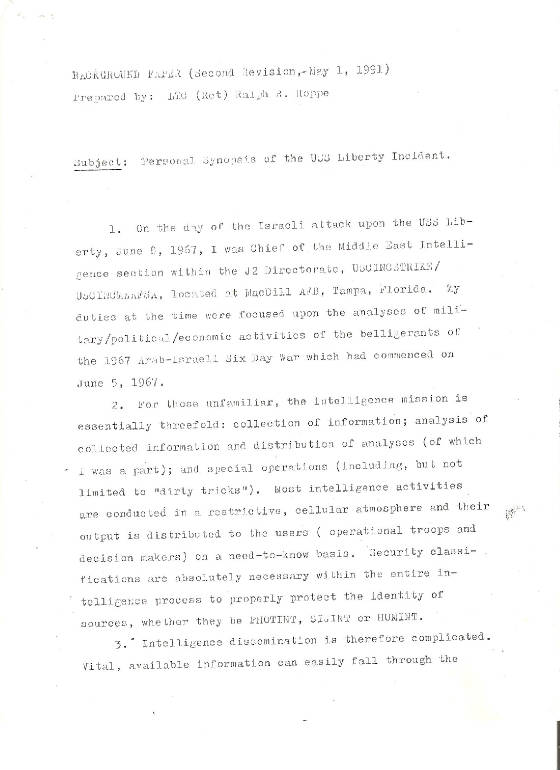
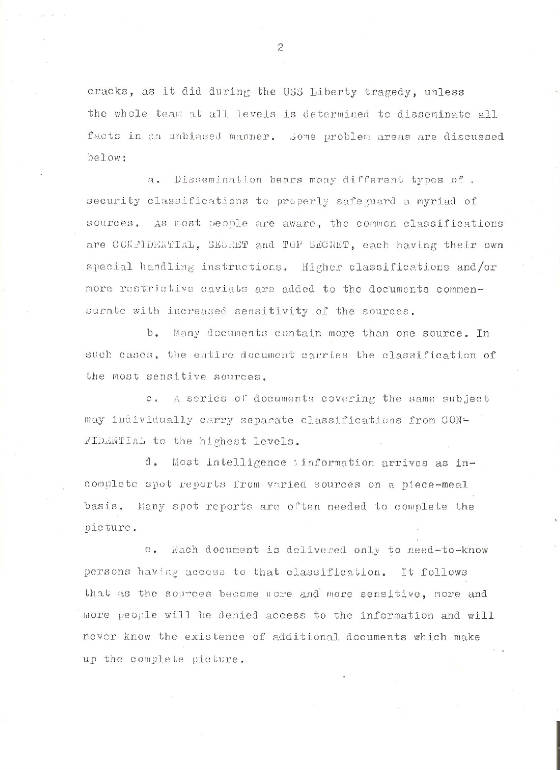


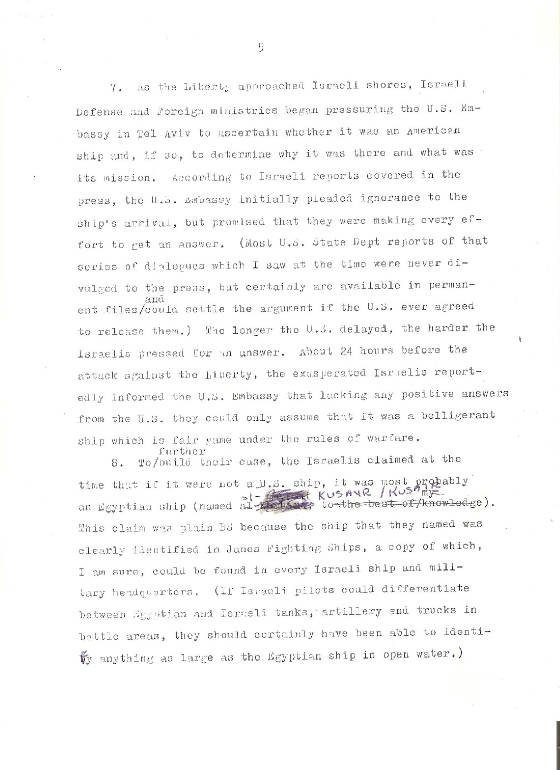
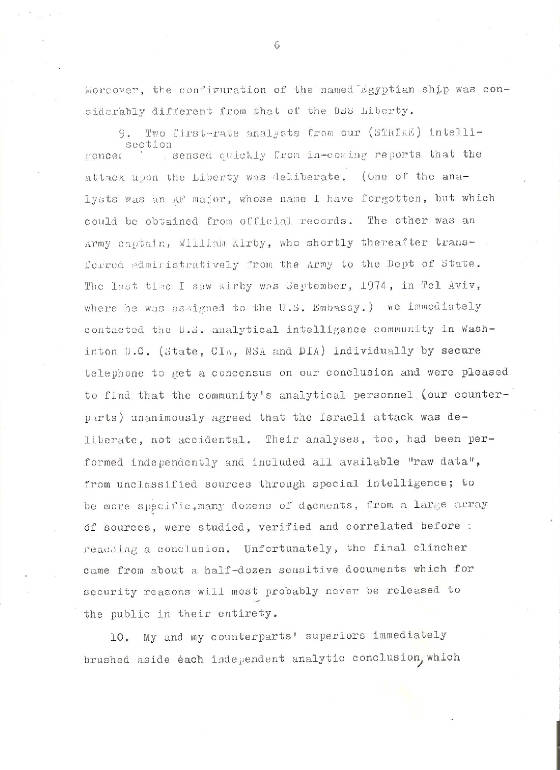

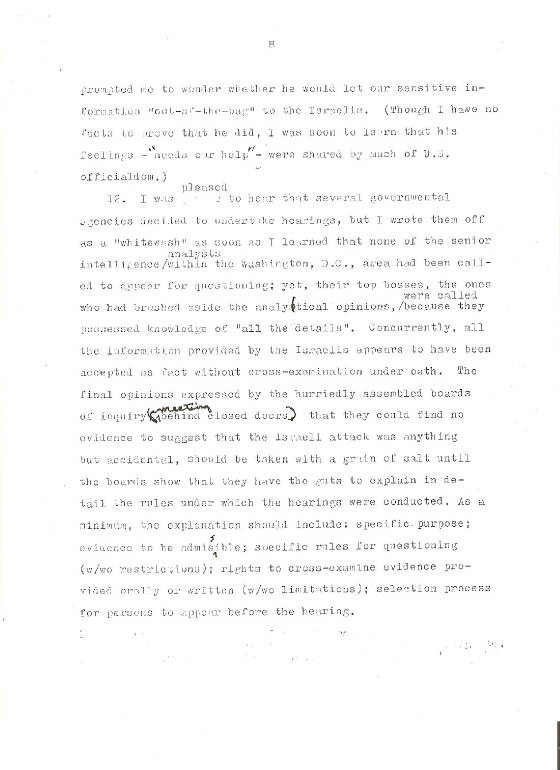
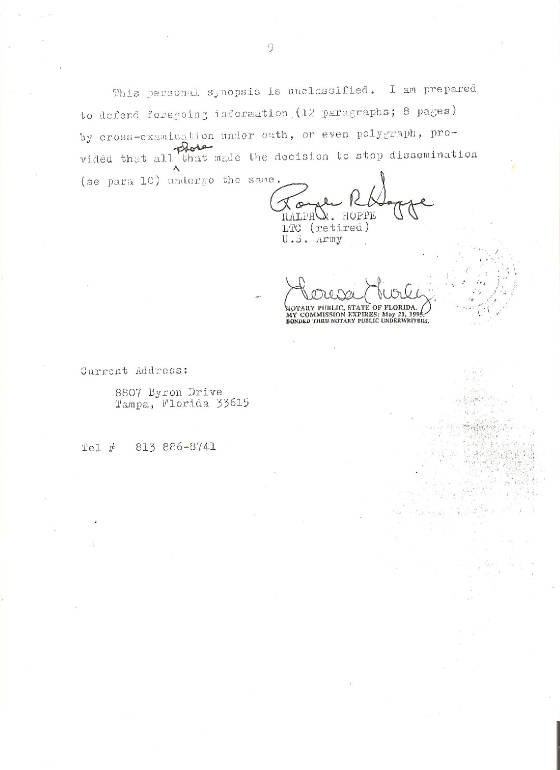
|

